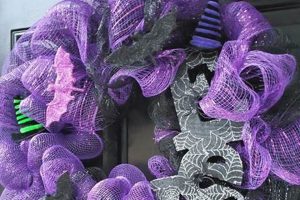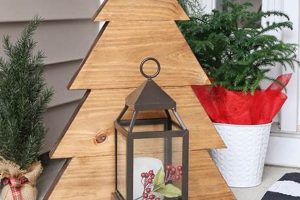A decorative yard ornament constructed from repurposed glass bottles arranged on a tree-like structure fabricated from metal or wood. This craft project involves affixing bottles, often in vibrant colors, onto the branches of the supporting framework. The completed creation is typically placed in gardens or outdoor spaces as a form of artistic expression.
The appeal stems from its potential to transform discarded materials into visually striking displays. This practice provides an avenue for creative reuse and sustainable landscaping. Furthermore, these arrangements have roots in African and Southern United States traditions, where glass receptacles were believed to trap evil spirits, adding cultural significance to their aesthetic value.
The subsequent sections will elaborate on design considerations, construction techniques, suitable materials, and alternative methods for creating similar artistic displays, providing a complete guide for those seeking to construct such an object.
Construction and Display Recommendations
The following outlines several best practices for planning, assembling, and exhibiting the subject decorative item, maximizing both its aesthetic value and structural integrity.
Tip 1: Material Selection: Opt for durable materials, such as powder-coated steel or treated lumber, for the primary support structure. This ensures the longevity of the installation, particularly in regions with inclement weather. Employ UV-resistant coatings on any painted surfaces to prevent fading and degradation.
Tip 2: Bottle Preparation: Thoroughly clean the bottles prior to mounting. Remove any labels or adhesive residue to ensure a clean and professional aesthetic. Consider using bottles of varying sizes and colors to create visual interest.
Tip 3: Secure Attachment: Implement a robust bottle attachment method. Welding, high-strength adhesive, or mechanically fastened brackets can be employed, depending on the chosen materials. Ensure that the attachment point can withstand wind loads and potential impacts.
Tip 4: Foundation Stability: Construct a stable and level foundation for the structure. A concrete footing or a buried support system will prevent tipping or collapse, particularly on uneven terrain.
Tip 5: Spacing and Arrangement: Carefully plan the spacing and arrangement of the bottles to achieve a balanced and visually appealing composition. Avoid overcrowding, which can detract from the individual bottles features.
Tip 6: Safety Considerations: Inspect the completed structure regularly for loose bottles or structural weaknesses. Address any issues promptly to prevent potential hazards. Consider the proximity to walkways and play areas to mitigate risks associated with broken glass.
Tip 7: Environmental Considerations: Site the exhibit in an area that receives adequate sunlight while minimizing potential shading of adjacent plants. Be mindful of wind patterns and ensure the installation does not obstruct views or create a nuisance for neighbors.
Adhering to these recommendations will facilitate the creation of a durable, visually appealing, and safe garden ornamentation. This approach promotes both artistic expression and responsible landscaping practices.
The concluding section will summarize the essential considerations for those undertaking similar artistic endeavors, reinforcing the principles of sustainability and creative resourcefulness.
1. Structural Integrity
The success of such garden ornamentation is inextricably linked to the structural integrity of its supporting framework. The framework must withstand the cumulative weight of numerous glass bottles, often over a prolonged period, in addition to environmental stressors such as wind, rain, and temperature fluctuations. Failure to adequately engineer the structure can result in collapse, causing potential hazards due to shattering glass and rendering the ornamentation aesthetically worthless. For instance, frameworks constructed from insufficiently treated wood are prone to rot and eventual failure, especially in humid climates. Similarly, metal structures lacking proper corrosion protection may weaken over time, leading to structural instability.
Proper material selection and construction techniques are paramount in ensuring long-term stability. Welding or bolting techniques should be employed instead of relying solely on adhesives for joining components. The foundation must be designed to provide a stable base, preventing tipping or sinking into the ground, especially in areas with soft soil. For example, a broad concrete footing provides a stable foundation, while using galvanized steel resists corrosion. Moreover, regular inspection and maintenance, including tightening bolts and addressing any signs of decay or corrosion, can prevent catastrophic failures.
In summary, structural integrity is not merely a desirable attribute but a fundamental requirement for safety and lasting visual impact. Neglecting this critical aspect undermines the entire endeavor, transforming a potentially attractive garden feature into a hazardous eyesore. Proper planning, careful material selection, and diligent maintenance are essential for realizing a secure and sustainable creation.
2. Bottle Color Harmony
Achieving visual coherence in decorative structures necessitates careful consideration of bottle color harmony. This harmony dictates the aesthetic appeal and contributes significantly to the overall success of the object. Strategic selection and arrangement of bottle colors transform a collection of repurposed glass into a unified and visually engaging art piece.
- Analogous Color Schemes
Employing analogous color schemes, which utilize colors adjacent to one another on the color wheel, creates a harmonious and soothing effect. An arrangement featuring various shades of blue and green, for example, evokes a sense of tranquility. This approach yields a naturally pleasing palette.
- Complementary Color Schemes
In contrast, complementary color schemes pair colors from opposite sides of the color wheel, producing a vibrant and dynamic visual. Combining red and green or blue and orange generates high contrast and visual interest. Careful application of these schemes prevents a potentially chaotic or overwhelming appearance.
- Monochromatic Color Schemes
A monochromatic scheme involves using variations of a single color. This method produces a sophisticated and unified look. For example, an arrangement featuring different shades of blue, from light sky blue to deep navy, offers a subtle yet impactful visual statement.
- Consideration of Bottle Texture and Transparency
Beyond hue, variations in bottle texture and transparency influence the perception of color. Opaque bottles display color more intensely, while transparent bottles allow light to filter through, creating subtle variations in tone. The interplay of these textural and transparent qualities enhances the complexity and visual depth.
The integration of thoughtful color arrangements elevates the overall visual impact of any such structure. Color serves as a unifying element, transforming disparate glass items into a cohesive art installation, enriching the aesthetic value and broadening appeal.
3. Secure Bottle Attachment
The functional and aesthetic longevity of such a garden ornamentation is fundamentally dependent on the robustness of the bottle attachment method. This aspect represents a critical engineering challenge, as the glass vessels must withstand environmental forces such as wind and gravity, preventing detachment and potential breakage. The method employed directly influences the overall structural integrity, impacting the safety and visual appeal of the completed installation. A failure in this area negates any prior effort invested in design and material selection, rendering the construction essentially useless.
Various attachment techniques can be utilized, ranging from industrial-strength adhesives to mechanical fasteners like screws and bolts. The selection of an appropriate method hinges on factors such as the type of material used for the framework, the size and weight of the bottles, and the prevailing weather conditions in the installation location. For metal frameworks, welding or the use of bolted brackets provide a durable solution. Wooden structures may benefit from construction adhesive paired with screws, ensuring a firm grip without compromising the wood’s integrity. Examples of failures due to inadequate attachment abound; instances of bottles detaching during windstorms underscore the importance of over-engineering this critical element.
In summation, secure bottle attachment is not merely a detail but a core design consideration. The method employed directly impacts safety, structural longevity, and overall aesthetic appeal. Prioritizing robust attachment techniques transforms a potentially fleeting garden novelty into a lasting expression of creative resourcefulness, mitigating hazards and ensuring enduring visual interest.
4. Base Foundation Stability
The structural integrity of any freestanding yard ornamentation, is directly linked to the stability of its base foundation. This is particularly salient in the construction of bottle trees, where the weight of the bottles and the overall height of the structure create a high center of gravity. A compromised foundation invites tipping, collapse, and potential hazards arising from shattered glass.
- Soil Composition and Load-Bearing Capacity
Soil’s composition directly affects its ability to bear the weight of the structure. Loose or unstable soils, such as sandy loam or clay-rich soils prone to expansion and contraction, necessitate enhanced foundation designs. Without proper consideration, the structure may gradually sink or shift, leading to instability. For example, constructing a bottle tree on uncompacted fill dirt is highly likely to result in settling and leaning over time.
- Foundation Footing Design
The design of the footingthe portion of the foundation that directly interfaces with the groundis critical for distributing the load and preventing localized pressure that could cause settling. Options range from simple concrete pads to buried piers extending below the frost line. The choice depends on factors like soil type, structure size, and local climate. A shallow footing in a region with frequent freeze-thaw cycles is prone to heaving, compromising the structure’s integrity.
- Anchoring and Stabilization Techniques
In addition to the footing, anchoring techniques provide additional stability, particularly in areas subject to high winds. Methods include burying support posts, using ground anchors, or incorporating a wider base to increase the structure’s resistance to tipping. Structures lacking adequate anchoring are vulnerable to being toppled by strong gusts, posing a safety risk and causing potential damage.
- Drainage and Water Management
Proper drainage is essential to prevent water accumulation around the base of the structure. Excessive moisture can weaken the soil, promote corrosion of metal components, and accelerate decay in wooden elements. Implementing drainage systems, such as French drains or grading the surrounding area to direct water away from the base, mitigates these risks. A structure sited in a poorly drained area is susceptible to foundation erosion and subsequent instability.
These facets highlight the imperative of meticulous planning and execution in constructing a stable foundation. The selection of appropriate materials, careful consideration of soil conditions, and implementation of effective anchoring and drainage strategies are crucial for creating garden ornamentation that is not only visually appealing but also safe and durable, able to withstand the test of time and environmental pressures.
5. Environmental Impact
The construction of yard decorations inherently presents environmental considerations, and the “Environmental Impact” directly correlates with materials used and construction methods applied. The creation has the potential to be a responsible reuse endeavor or a source of avoidable environmental strain.
Positive impact stems primarily from the recycling of glass bottles. Diverting these items from landfills reduces waste volume and conserves resources otherwise required for new glass production. However, the environmental calculus shifts if unsustainable or ecologically harmful materials are employed in the structure itself. The use of improperly treated lumber that leaches chemicals into the soil, or the application of non-compliant paints releasing volatile organic compounds (VOCs), offsets the benefits gained from glass reuse. Therefore, material selection should prioritize recycled, reclaimed, or sustainably sourced options to minimize ecological footprint.
Moreover, the longevity of the construction bears on its overall environmental profile. A structure built to withstand the elements requires less frequent repair or replacement, reducing the cumulative demand for resources over time. In conclusion, minimizing overall negative environmental effects necessitate careful material selection and construction practices.
6. Artistic Visual Balance
Artistic visual balance represents a fundamental design principle influencing the aesthetic success of such projects. This principle, when effectively applied, transforms a collection of disparate glass objects into a harmonious and visually pleasing garden feature. A lack of visual equilibrium detracts from the overall impact, resulting in a chaotic and unappealing display.
- Symmetrical Arrangement
Symmetrical balance is achieved through the mirrored arrangement of elements around a central axis. This approach creates a formal and stable aesthetic. For example, positioning identical bottles on corresponding branches produces a visually predictable and harmonious composition. Symmetrical designs convey order and control but may lack dynamism.
- Asymmetrical Arrangement
Asymmetrical balance utilizes contrasting elements to achieve equilibrium without mirroring. This approach offers a more dynamic and informal aesthetic. Employing different bottle colors and sizes on opposing sides, while maintaining a sense of visual weight, creates interest. This style demands careful consideration to prevent one side from overpowering the other.
- Color Distribution and Visual Weight
The distribution of color influences the perceived visual weight of different areas. Bright and saturated colors draw the eye, creating focal points and influencing balance. Strategic placement of lighter or darker shades can compensate for variations in bottle size or shape. For instance, a single large, dark-colored bottle can balance a cluster of smaller, lighter-colored bottles.
- Spatial Harmony and Negative Space
The effective use of negative space contributes to the overall visual balance. Allowing sufficient space between bottles prevents overcrowding and allows each element to be appreciated individually. Strategic use of empty branches or voids creates visual breathing room and enhances the sense of harmony. A composition where bottles are densely packed may appear cluttered and lack visual appeal.
The principles of visual equilibrium directly impact the aesthetic appeal of this project. A balanced composition, whether achieved through symmetry, asymmetry, color distribution, or use of negative space, transforms a utilitarian assemblage of glass into an aesthetically pleasing yard ornamentation.
7. Cultural Significance
The origins can be traced to African traditions, specifically the Kongo people, who believed that glass bottles could trap malevolent spirits. This practice migrated to the Southern United States through enslaved Africans, where the structures served as spiritual protectors of homes and gardens. The color blue was particularly significant, believed to possess heightened spiritual power. Consequently, the construction reflects an enduring cultural heritage, extending beyond mere aesthetic value.
The persistence of is a tangible representation of cultural continuity and adaptation. It serves as a physical reminder of historical beliefs and practices passed down through generations. Modern expressions often incorporate diverse colors and designs, reflecting evolving artistic sensibilities while retaining the underlying connection to ancestral traditions. Examples of these structures can be observed throughout the Southern United States, frequently in rural areas, demonstrating the enduring cultural footprint.
Understanding enhances appreciation for their significance. The structures become more than just decorative items; they represent a tangible link to historical and spiritual practices. By acknowledging and respecting this cultural context, modern interpretations can become informed and meaningful expressions, rather than mere appropriations of a cultural symbol.
Frequently Asked Questions
The subsequent questions and answers address common inquiries and potential misconceptions regarding the construction, maintenance, and cultural significance of bottle trees.
Question 1: What materials are most suitable for constructing a durable support structure?
Powder-coated steel or treated lumber are frequently recommended due to their resistance to corrosion and decay. The choice depends on aesthetic preferences and available resources. Untreated wood is generally not recommended due to its susceptibility to environmental degradation.
Question 2: How can bottles be securely attached to the framework to withstand wind?
Welding (for metal frames), high-strength construction adhesive, or mechanical fasteners like screws and bolts offer robust solutions. The chosen method must account for the weight of the bottles and the expected wind loads in the installation area.
Question 3: Is a concrete foundation necessary for all constructions?
The necessity of a concrete foundation depends on the size and weight of the structure, as well as the soil conditions. Smaller structures on stable soil may only require buried support posts. Larger, heavier constructions, or those on unstable soil, benefit from a concrete footing for enhanced stability.
Question 4: What measures can be taken to minimize the environmental impact?
Utilizing recycled materials, such as reclaimed lumber or repurposed metal, reduces resource consumption. Opting for water-based, low-VOC paints minimizes the release of harmful chemicals. Responsible disposal of construction waste is also essential.
Question 5: How can balance of bottle colors be achieved and what is considered aesthetically pleasing?
Balance is achieved by carefully arranging colors to avoid an overwhelming or chaotic appearance. Employing analogous, complementary, or monochromatic color schemes enhances visual harmony. Consideration should be given to the transparency and texture of the bottles too.
Question 6: What is the cultural context of using a blue color for bottles?
In African and Southern United States traditions, the color blue is believed to possess spiritual power, warding off negative energies. While modern adaptions use many colors, the frequent use of blue bottles stems from this historical belief.
In summary, careful planning, material selection, and construction techniques are crucial for creating a stable, visually appealing, and culturally sensitive garden display.
The following section will offer alternative design and display options, expanding the possibilities for personalizing these artistic expressions.
Conclusion
This exploration of “diy bottle tree” construction has addressed critical aspects ranging from structural integrity and material selection to aesthetic considerations and cultural significance. The preceding sections underscored the importance of thoughtful planning and responsible execution in creating garden ornaments that are both visually appealing and environmentally sound. A comprehensive understanding of these facets ensures the longevity and safe exhibition of these artistic installations.
The information provided enables informed decision-making in pursuing these creative projects. By adhering to sound engineering principles, embracing sustainable practices, and acknowledging the historical context, individuals can transform discarded materials into enduring expressions of artistry. Continued innovation in design and technique promises further evolution of these creations, solidifying their role as both artistic statements and embodiments of resourceful adaptation.







